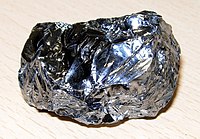
Photo from wikipedia
Abstract. The large majority of surface plasmon resonance (SPR)-based devices use noble metals, namely gold or silver, in their manufacturing process. These metals present low resistivity, which leads to low… Click to show full abstract
Abstract. The large majority of surface plasmon resonance (SPR)-based devices use noble metals, namely gold or silver, in their manufacturing process. These metals present low resistivity, which leads to low optical losses in the visible and near-infrared spectrum ranges. Gold shows high environmental stability, which is essential for long-term operation, and the lower stability of silver can be overcome through the deposition of an alumina layer, for instance. However, their high cost is a limiting factor if the intended target is large-scale manufacturing. This work considers a cost-effective approach through the selection of aluminum as the plasmonic material and hydrogenated amorphous silicon instead of its crystalline counterpart. This SPR structure relies on Fano resonance to improve its response to refractive index deviations of the surrounding environment. Fano resonance is highly sensitive to slight changes of the medium, hence the reason we incorporated this interference phenomenon in the proposed sensing structure. We report the results obtained when conducting finite-difference time-domain algorithm-based simulations on this metal–dielectric–metal structure when the active metal is aluminum, gold, and silver. Then, we evaluate their sensitivity, detection accuracy, and resolution. The obtained results for our proposed sensing structure show good linearity and similar parameter performance as the ones obtained when using gold or silver as plasmonic materials.
Journal Title: Optical Engineering
Year Published: 2018
Link to full text (if available)
Share on Social Media: Sign Up to like & get
recommendations!